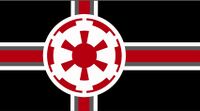Thrashian Imperial Army
| Imperial Army | |
|---|---|
| Active | 359 YBCE ~ Present |
| Country | Thrashia |
| Allegiance | Imperial Throne |
| Branch | Army |
| Role | planetary assault, planetary occupation, protect vital national interests, and fulfill national military responsibilities |
| Size | 500,000,000+ (active), 1,200,000,000+ (reserve) |
| Motto(s) | 'Gloria Exercitus Et Imperii' |
| March | Imperial March |
| Equipment | Thrashian Imperial Army Equipment |
The Imperial Army is the terrestrial component of the Thrashian Imperial Military. The men and women that have served within the Imperial Army since it's inception have served with distinction and honor for centuries. There are three primary components that make up the Imperial Army: the Clone Legions, the Stormtrooper Corp, and the Imperial Army; although the latter most is also referred to as the 'General Army' or 'Regular Forces'.
Role
The operational goal and purpose of the Imperial Army is surface superiority during instances of ground warfare, and are equipped with the means of seizing and defending a planet. While the Imperial Navy controls space and the Stormtrooper Corps leads assaults and established bridgeheads, only the Imperial Army is capable of deploying the heavy equipment and of sustaining the long operations required to gain control of planets. As such, the Army encompasses various infantry, armored cavalry, special forces, artillery operators, engineers, scouts, and drivers that can number in the tens of trillions. This also means that while they are capable of decisive planetary operations and sustained surface superiority, it takes longer to deploy their specialized formations and heavy equipment than other branches of the Imperial Military. In particular this pertains to the Imperial Regulars.
Aside from this, the Army also has the role of eliminating military threats to the established Imperial political order on planetary surfaces or other inhabited complexes. If on an enemy planet, the Imperial Army is to engage and defeat any local military force that is capable of resistance, in order to ensure the transition of control of the planet towards the Empire. The Army when engaged in operations could expect support from the Imperial Navy during the initial drop phase, which included suppressing fire against particularly hard or well-armed targets, as well as "force reduction attacks" meant to destroy enemy assets capable of interfering with reorganization after the drop. The Army during later phases of an operation is also allowed to pre-plan for orbital bombardments on specific targets. If the operation proved vital enough, the Army will work together with naval units on the ground to provide fire support upon being called upon.
The Imperial Army's tactics had emphasized demoralizing the enemy, specifically through the use of overwhelming firepower to leave them shell-shocked and helpless in the face of a massive, numerically superior frontal assault. This has been changing to a more fluid, maneuver-based method of warfare. The Imperial Army had emphasized the frontal assault as the centerpiece of ground warfare, which drove the development of massive walkers like the AT-AT, which could use its immense height to deliver overwhelming firepower against targets from far outside the range of most artillery or ground vehicles. Repulsortanks and other such repulsorlift vehicles, which had supposedly been considered better suited for "mid-intensity" combat, such as urban warfare and fast-moving campaigns in grassy or forested terrain, were brought back into vogue. The age of ponderous, massed walker assaults is considered a thing of the past. Such tactics are only employed on technologically backward worlds where the native population may be easily cowed by a show of such force.
Organization
The highest organizational body of the Imperial military is the Imperial Army High Command, which is largely ceremonial and composed of courtiers from the Imperial Court. Below this is Army Sectorial Command, the organizing body of senior Generals that directed all operations of the Imperial Army, led by the Army Chief of Staff. Army Sectorial Command oversees all aspects of the Imperial Army and operates and commands the ground battles, and anything within the Imperial Army's jurisdiction, coordinating the war effort of the Thrashian Empire. Beneath the ASC is the Legion Command, Stormtrooper Command, and Army Command; each of which is charge with overseeing their particular slice of the Imperial Army's over all structural pie.
Imperial Army Regulars
Beneath the Army Command, the ranking organization that oversees the non-clone and non-Naval elements of the Imperial Army, are several branches and suborganizations that help to define and enable the Imperial Army to carry out it's duties. They are as follows: Acquisition Command, Air Defense Artillery Corps, Armor Command, Civilian Affairs, Information Operations Command, Strategic Intelligence Command, Chemical and Biological Warfare Command, Public Affairs Office, Finance Corps, Infantry, Logistics, Operations Research and Analysis Command, Inspector General, Army Intelligence Corps, Medical Corps, Military Police Corps, Psychological Operations Command, Infantry, Quartermaster Corps, Special Forces, Ordnance Corps, Transportation Corps, Signal Corps, and Simulation Operations Command.
